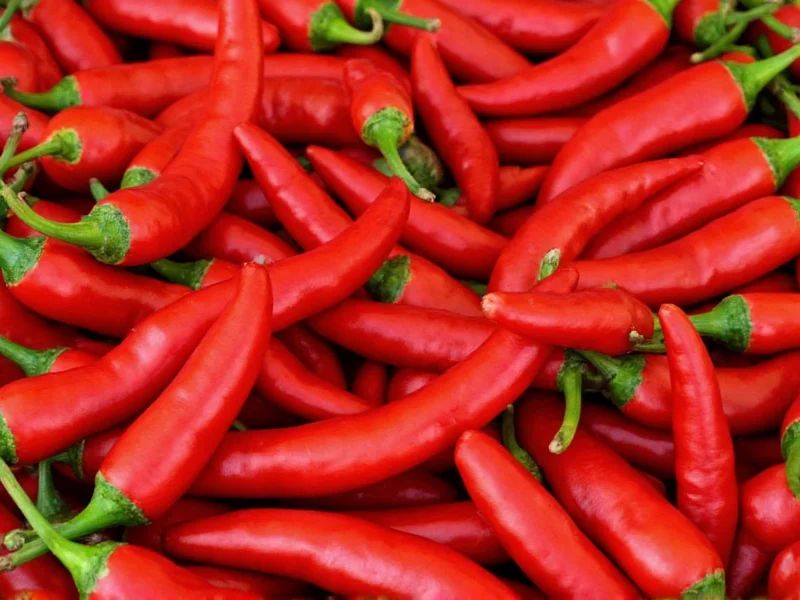Understanding Thai Chilies: A Culinary Essential
When exploring Southeast Asian cuisine, particularly Thai cooking, understanding what are thai chilies becomes fundamental to authentic flavor creation. These tiny powerhouses deliver complex heat that defines many classic dishes. Unlike larger chili varieties, Thai chilies contain concentrated capsaicin throughout their entire structure, not just in the seeds and membranes.
Physical Characteristics and Varieties
Thai chilies typically measure between 1-2 inches in length with a slender, tapered shape. They grow upright on the plant rather than hanging down like many other chili varieties. The most common types include:
| Variety | Color | Heat Level (Scoville) | Flavor Profile |
|---|---|---|---|
| Thai Bird's Eye | Green to Red | 50,000-100,000 | Floral, citrusy, intense heat |
| Prik Yuak | Yellow | 30,000-50,000 | Slightly sweeter, moderate heat |
| Prik Chee Fah | Red | 10,000-30,000 | Milder, slightly sweet |
Heat Level Comparison
Understanding how hot are thai chilies compared to other peppers puts their intensity in perspective. Thai chilies range from 50,000 to 100,000 Scoville Heat Units (SHU), making them significantly hotter than:
- Jalapeños (2,500-8,000 SHU) - Thai chilies are 6-40 times hotter
- Serranos (10,000-23,000 SHU) - Thai chilies are 2-10 times hotter
- Habaneros (100,000-350,000 SHU) - Similar or slightly milder than Thai chilies
Many people wonder if thai bird's eye chili vs regular chili makes a difference - the answer is yes. "Regular" chilies vary widely, but Thai bird's eye chilies specifically refer to the small, potent variety essential in Thai cooking.
Culinary Applications
Thai chilies serve as the fiery backbone of countless Southeast Asian dishes. Chefs use them in various forms:
- Raw in salads and dipping sauces like nam prik
- Finely chopped in curry pastes
- Whole in soups like tom yum for controlled heat infusion
- Dried for extended shelf life and concentrated flavor
- Pickled as a condiment
The question of what are thai chilies used for extends beyond heat - they contribute complex flavor notes that balance sweet, sour, and salty elements in Thai cuisine. Professional chefs often remove seeds only when creating dishes for heat-sensitive palates, as much flavor resides in the seeds and membranes.
Finding and Substituting Thai Chilies
When searching where to buy thai chilies near me, check Asian grocery stores, farmers markets, or well-stocked supermarkets. Many grocery chains now carry them in the international or fresh produce sections. For those unable to find authentic Thai chilies, suitable substitutes include:
- Serrano peppers (for fresh applications, though milder)
- Red pepper flakes (for dried applications)
- Hungarian wax peppers (for milder dishes)
- Tabasco peppers (similar heat profile)
Understanding thai chili pepper substitutes becomes crucial when recreating authentic Thai recipes outside Southeast Asia. The closest substitute is often serrano peppers, though you'll need to adjust quantities to match heat levels.
Storage and Handling Tips
Proper storage extends the life of these delicate peppers. For short-term use (1-2 weeks), keep fresh Thai chilies in a perforated plastic bag in the refrigerator crisper drawer. For longer storage:
- Freeze whole peppers in an airtight container for up to 6 months
- Dry peppers by threading them on string in a warm, dry place
- Pickle in vinegar for flavorful condiments
When handling extremely hot varieties, wear gloves to prevent skin irritation. Never touch your face after handling chilies, and wash hands thoroughly with soap and water. If you experience burning, dairy products like milk or yogurt provide relief better than water.
Nutritional Profile and Health Benefits
Thai chilies offer more than just heat. They contain significant amounts of:
- Vitamin C (more than oranges by weight)
- Vitamin A (from beta-carotene)
- Vitamin B6
- Potassium
- Antioxidants like capsaicin
Research suggests capsaicin may boost metabolism, reduce inflammation, and provide pain relief. However, these benefits come with moderation - consuming excessive amounts can cause digestive discomfort.
Regional Variations
While commonly called Thai chilies, similar varieties appear across Southeast Asia with regional differences. In Thailand, green chilies (prik kee noo suan) typically indicate immaturity, while red chilies (prik kee noo) are fully ripe and significantly hotter. Some regions cultivate specific varieties like the slightly sweeter Prik Yuak (yellow chilies) or the milder Prik Chee Fah.
Many home cooks confuse whether thai green chili vs red thai chili makes a difference - it absolutely does. Green chilies offer grassier, more vegetal notes with moderate heat, while red chilies deliver intense, floral heat that defines many classic Thai dishes.











 浙公网安备
33010002000092号
浙公网安备
33010002000092号 浙B2-20120091-4
浙B2-20120091-4